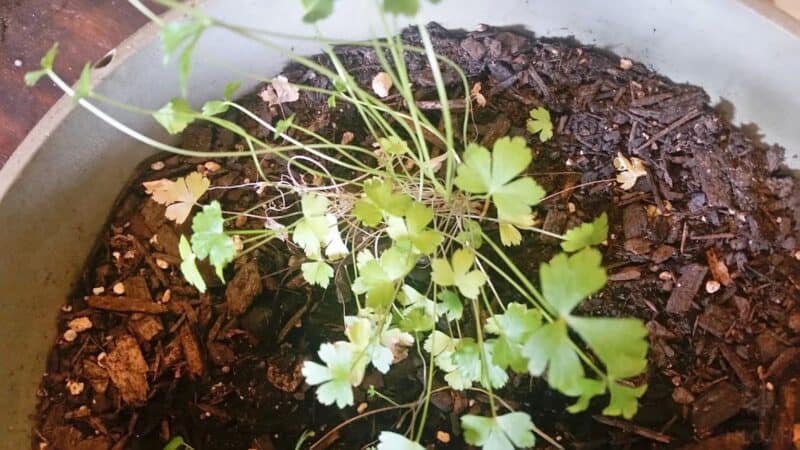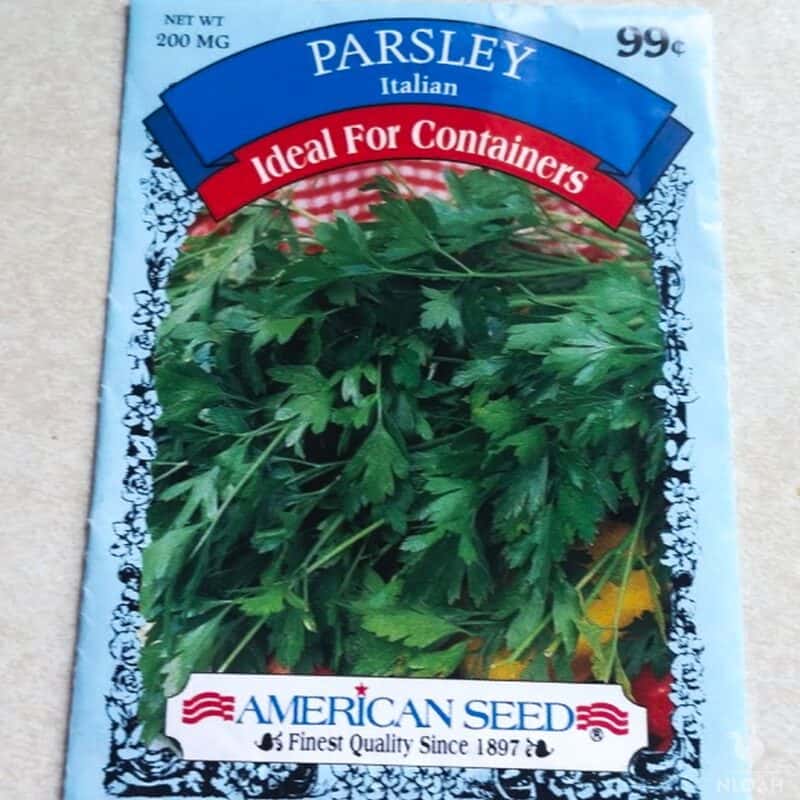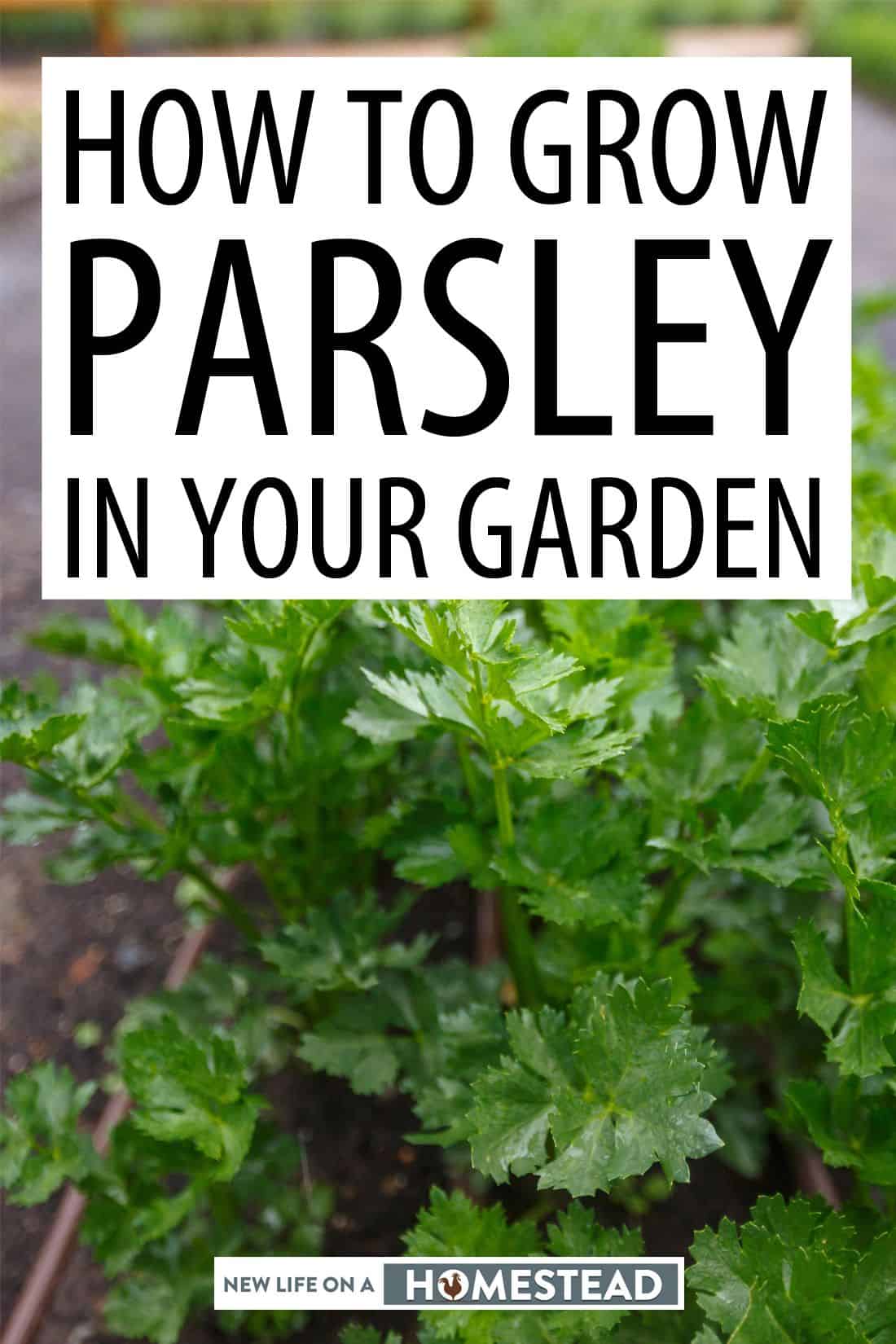For many people, parsley is nothing more than a garnish that rests off to the side of the dinner plate. For others, parsley is a necessary staple in the kitchen, providing a whole host of flavors and uses for home chefs.
I happen to fall into the latter category.

Although I wasn’t a huge fan of parsley growing up, this had less to do with a dislike of the herb’s flavor and more to do with the fact that I had no idea what it was! As an adult, I enjoy adding parsley to my favorite recipes, including scrambled eggs, sauces, and fish dishes.
Best yet, parsley is remarkably easy to grow. I’ve grown parsley for several years in my garden and I’ve always found it to be a hardy, low-maintenance kind of plant.
If you’re thinking about trying your hand at growing this herb, this article will tell you everything you need to know when it comes to how to grow parsley in your garden.
Why You Should Grow Parsley
A versatile herb, parsley can be tied into many different dishes, cuisines, and cooking styles. Just like salt, parsley helps enhance the natural flavors in a dish, and ties them all together.
Whether you’re making a tabbouleh salad or a cheesy omelet, parsley can really help take the flavors of your meal to the next level.
Parsley is also loaded with nutrients. It has more vitamin C than an orange, and is also rich in antioxidants. One unique quality of this herb is its high vitamin K content, which can not only help give you energy, but can also help to protect you against certain types of disease.
This herb is an easy to grow plant – in fact, all you need is a sunny location and a bit of water. Its lush green foliage offers gardeners ornamental value in addition to its culinary and medicinal benefits.
Types of Parsley
There are several kinds of parsley that you might consider growing in your garden. What they all have in common is that they are biennial plants.
If you’re not familiar with the word “biennial,” it simply refers to a type of plant that comes back after two gardening seasons. The plant will produce leaves, go to seed, and develop a taproot. This is a sharp contrast to plants that are perennial – returning every year – and those that are annual – dying after every season.
Because parsley is a biennial plant, you’ll get tasty, nutritious leaves during the first year, and then the plant will go to seed the second year (if you’re growing in a zone that is warm enough to support the plant through the winter months, that is).
You can also eat the taproot of this plant, although most people ignore the root in favor of the tender leave.
Closely related to carrots, celery, and dill, parsley can be broken down into two major categories: curly leaf and flat-leaf.
Flat-leaf parsley is, by far, the most common type of parsley grown by home cooks. It has a vibrant flavor and is easy to chop.
Curly parsley, on the other hand, is a better alternative if you want to use it as a garnish.
There is one more rare, less common type of parsley you might find, too. This one is usually used for culinary purposes, and has some of the most pungent leaves – so pungent, in fact, that many gardeners find them way too intense to eat and skip them in favor of other parsley varieties.
Known as soup parsley, parsnip parsley, or Hamburg parsley, this variety is usually eaten as a root instead of a leaf.

Growing Parsley from Seed
Regardless of where your parsley plants end up, it’s important that you choose the right location.
Like many other herbs, parsley grows well in a container. If you choose to paint paisley indoors, place the container near a warm, sunny window.
When starting parsley from seed – something that is not too difficult to do – you’ll need to be patient. Although parsley germinates readily, it takes some time for it to do so. When you start seeds indoors, do so about three months before the last expected frost.
That way, your plants will be nice and large when you’re ready to transplant them into the garden.
You may want to soak your parsley seeds overnight before you sow them indoors – this can improve your germination rates.
Sow your seeds about one inch apart at a depth of a quarter-inch deep. The soil needs to be kept moist. If you’d like, you can thin your parsley plants when the second set of true leaves appears.
Transplanting Parsley
If you start parsley from seed directly in the garden soil, wait until three to four weeks before the last expected frost. Parsley is frost-tolerant, as long as you give it a bit of a head start.
Otherwise, wait to transplant your started parsley plants until the danger of frost has passed (tender seedlings are going to be more sensitive to a chilling frost than seeds that have not quite germinated yet).
Once it’s established, parsley is quite hardy. In fact, it can survive temperatures as low as 10 degrees Fahrenheit (-12 Celsius). That being said, it can occasionally lose its leaves during long periods of freezing temperatures. You’ll see new growth as soon as the weather warms.
Plant your parsley plants in moist soil that is loamy and well-turned. Add a bit of compost just as you plant to increase the availability of nutrients for your parsley. Again, this plant does best in full sun, but it can also tolerate a small amount of shade.
If you started your parsley plants from seed, thin them to about nine or ten inches apart when they’re a few inches tall. If transplanting, space your seedlings roughly nine inches apart as well. This will give the roots plenty of room to develop without running the risk of overcrowding.
Caring for Parsley Plants
Weeding
Parsley can be a bit tough to get established at first in that it is a bit challenging to weed it. Because it is shallowly rooted and quite small at first, it’s tough to weed without disturbing the roots of the plant.
To overcome this challenge, you may want to consider mulching around your parsley plants. Simply lay down a one- to two-inch thick layer of mulch around your plants at planting time, and you shouldn’t have to worry about the weeds.
Mulch is a good idea for another reason, too. When you add a thick, dry mulch (or even a cloche) to your parsley plants when you are expecting severe winter weather, the mulch will help keep your plants protected and will guard the roots from the severe fluctuations.
Another way you can protect your parsley plants in the winter is to grow them in a protected area. For example, if you plant them near a wall or against a building with southern exposure, they’ll stay a lot warmer than if they were growing in the direct path of a cold, drying wind.
Watering
If you mulched around your parsley plants, as suggested above, you shouldn’t have too much trouble when it comes to watering your parsley. On average, you’ll only need to water during extremely dry spells – parsley is pretty drought-tolerant once established.
However, when your plant is still setting roots, you might want to water once a week or so. This will enable the plant to develop a strong root system, and will prevent the fragile leaves from wilting, too.
Fertilizing
You don’t have to fertilize your parsley plants, but it can be helpful if you want to give them a dose of nutrients (or if you didn’t amend the soil with compost prior to planting).
If you use synthetic fertilizer, use a balanced fertilizer with an equal N-P-K ratio. Otherwise, consider just applying a side dressing of a fertilizer that is high in nitrogen, such as fish fertilizer or emulsion. You can also add compost tea, which will help encourage good leaf growth.
Companion Plants
Parsley is a valuable companion plant for many kinds of herbs, flowers, and vegetables in your garden. Its strong aroma helps to repel a large assortment of pests.
Many home gardeners report that planting parsley near roses can help improve the aroma and hardiness of your roses, though it’s not quite understood why this might be.
You can also grow parsley near corn, asparagus, and tomatoes. The Only plants you should avoid planting near parsley are those that are closely related to this herb, such as carrots, fennel, dill, and celery. They may be vulnerable to the same pests and diseases.
For example, parsley along with other plants in the Apiaceae family can be prone to certain fungal diseases. These diseases usually appear during times of warm, wet weather.
The most common fungal issues you will have to worry about include leaf spot, root rot, crown rot, and gray mold (also known as Botrytis blight).
Pests and Diseases
The fungal diseases mentioned above – such as leaf spot and root rot – are most common in soil that remains consistently wet.
To combat this, you will need to remove any damaged plants and thin them generously to help improve air circulation. You should also skip overhead watering and water from below instead.
Using a drip line is a great way to prevent diseases, particularly fungal diseases, from spreading among your plants. Bacteria is often present in the soil and can be splashed onto your leaves when you water overhead. This will infect your plants as a result.
There aren’t too many pests that will target your parsley plants, particularly because they tend to have such a pungent odor that it keeps most pests away. However, you will want to watch out for parsley worms, cutworms, armyworms, carrot worms, rabbits, and deer.
While the larger mammalian pests can be kept out with some simple fences, insect pests will need to be kept at bay by hand-picking and other observatory strategies.
Harvesting Parsley
Parsley is ready to be harvested in the first year if you only plan on harvesting its leaves (which for most growing zones, tends to be the case).
Select the stalks that are furthest from the center, allowing the inner leaves and stalks to remain so that plant may keep growing.
You can also save the stems and use those in your cooking, too. They are loaded with flavor and although they can be a bit tough, they taste great when softened and cooked.
The leaves can be harvested as soon as the stem they are connected to has at least three distinct segments.
If you choose to harvest the second year of growth, the leaves might be more sparse, and lack some of the telltale parsley flavor they hold the year before.
Let the parsley bloom to attract beneficial pollinators, like bees, and wait until you can collect the seeds. You can save the seeds to sow them the following year.
Once the plant has flowered, you can harvest your parsley root. It is incredibly flavorful and can be shaved over salads for a delicious crunch.
Using and Storing Parsley
You can use both curly leaf and flat-leaf parsley in your kitchen. Curly leaf parsley, as I mentioned earlier, is typically used as a garnish. However, you can also freeze or dry it. It has a distinct appearance on the dinner plate!
Flat-leaf parsley is used more often for cooking. It’s not quite as “fancy looking” as curly-leaf parsley – however, it has a deeper, more robust flavor and is much easier to cut and handle. It’s often used in salad dressings, sauces, soups, and stuffing.
Parsley is also vital for classic herb blends like fines herbs, poultry, bouquet garni, and various Italian seasonings. I love using parsley in my herb crust for meat and fish! It can also be sprinkled on eggs, potatoes, vegetables, and other dishes, too.
Since it has a similar effect as salt in your cooking, it can reduce the need to add salt to your favorite dishes, and help reduce your sodium intake.
You may find that fresh parsley will last longer in the refrigerator if you stash the stalks in a small container of water.
If you want to store longer than eight months, you should freeze the parsley – this will help it hold its flavor better than drying. Of course, you won’t be able to use either as a garnish, but they’ll still taste great in your cooking.
You can also make pesto with some basil, pine nuts, parmesan, and other ingredients, and store up a big batch of that for the freezer!
No matter how you choose to use or store your parsley, you’re sure to get good use out of it in your kitchen. Grow some in your garden (or even on your windowsill!) today so that you can reap all of the goodness of this delicious herb.


Rebekah is a high-school English teacher n New York, where she lives on a 22 acre homestead. She raises and grows chickens, bees, and veggies such as zucchini (among other things).

Hi Kendra!
The International Herb Association is celebrating Parsley is Herb of the Year 2021. I enjoyed your blog.